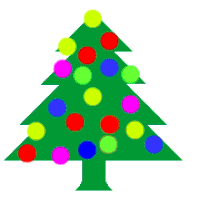

This Christmas millions of Canadians will set up a Christmas tree. Some will be artificial but most will be natural trees. Quite a few families will make expeditions to cut their own trees. The “tree” will be the warm and glowing centre of their Christmas celebration. This tradition has endured for many years. How did it get start?
For aeons communities have used trees or tree branches to make their homes festive. Legends tell of the decorated tree in winter celebrations long before there was a Christmas.
Egyptians brought palm branches into their homes in late December as a symbol of growing things. Romans trimmed trees with trinkets and topped them with an image of their sun god to celebrate Saturnalia. Druid sorcerers hung golden apples and lit candles on oak trees to celebrate the winter solstice.
ur modern Christmas Tree probably started in the middle ages, when a “Tree of Paradise” was carried through the streets in Medieval mystery plays. About 400 years ago, in Germany, this moored into the “Christbaum” (Christ Tree) which stood on a table surrounded by toys and plates of sweetmeats and later to a tree standing on the floor with which we are familiar. This spread through much of northern Europe by the 19th Century.
The first Christmas tree in Canada was most likely the tree set up by Baron Friederick von Riedesel in 1781 in Sorel, Quebec. The Baron, following the custom of his native Germany, cut down a balsam fir from the dense forest surrounding his home and decorated it with white candles.
The custom of using Christmas Trees became very popular when Queen Victoria had a tree set up 1848, in accordance with the German Christmas custom of Prince Albert’s childhood.
When buying a Christmas tree, it is important to buy a fresh tree and keep it fresh. There are two simple tests for freshness. Check the condition of the needles by taking a needle and trying to bend it. A needle from a fresh tree will bend easily but one from a dried out one will snap. The second test for freshness is to lift the tree a few inches off the ground and then bang it down on the stump end. If outside green needles fall off in abundance, the tree may not be fresh. Pine trees shed their inside needles every fall and sometimes needles lodge among the branches. This is a normal process and not the sign of an old or dry tree.
If you’ve purchased your tree a week or more before you intend to decorate, keep the trunk of the tree in water. Any large container will do. Simply make a fresh, straight cut across the trunk an inch up from the original cut. This opens the tree stem so it can take up water. Then plunge the trunk end immediately into fresh water.
Avoid the use of combustible decorations. Check all electric and connections. Do not use lights with worn or frayed cords and never use lighted candles. Place the tree away from fireplaces, radiators, television sets and other heat sources. These elements will prematurely dry your tree. And be sure to unplug tree lights before retiring at night and any time you leave home. Sensible precautions such as these ensure a safe and happy holiday.
Your tree has uses after the holiday season, too. Place it in the garden or backyard for use as a bird feeder. Orange slices, bread and suet will attract birds. In addition, your tree is biodegradable. The branches may be removed and used as mulch in your garden and the trunk can be used for fuel or chopped for mulch. Branch tips and needles can provide aromatic stuffing for sachets.
